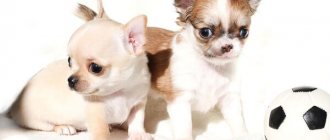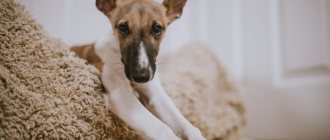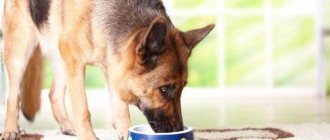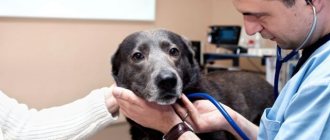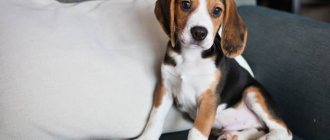Nowadays, the German Shepherd is a breed that can always protect and save from danger.
These are loyal and devoted dogs.
They also get along well with children.
They maintain excellent relationships with other pets.
Having and properly raising such a dog means finding a good friend and companion who will not leave you in difficult times.
The breed is suitable not only for protection and protection, but also for the family.
Let's find out about everything in detail.
Anatomy of the ear and what time should the ears “stand up”
At birth, the puppy's ears are not yet formed.
They are soft cartilage adjacent to the head. This cartilage is the dog's ear.
Over time, as the puppy begins to grow, the ear becomes stronger and increases in volume . As the dog grows, the cartilage will turn into an elastic plate that lacks blood vessels.
The cartilage plate is covered on both sides with a layer of connective tissue - this is the perichondrium. It ensures the development of the underlying cartilage.
The perichondrium contains many small vessels and capillaries.
They help the necessary substances needed for growth and strengthening to enter the cartilage. This is how the ear becomes: stem cells, like bricks, build the stem part of the cartilage.
Cartilage cells produce collagen and elastin . The strength of the ear depends on these substances.
Structural features
A shepherd's ears must correspond to the breed standard. All puppies are born initially without hearing or vision. Only from 2 weeks of age do babies begin to actively grow and open their eyes.
At birth, their ears are small, soft, and grow and develop slowly. The cartilage cannot come into proper growth until the puppy reaches 2 weeks of age. Afterwards, it begins to actively develop, thicken and increase in size along with the growth of the puppy.
The ear is covered on both sides with connective tissue, which allows it to avoid injury and actively develop. The cartilage itself is without blood vessels, but the outer perichondral tissue, on the contrary, has a developed system of capillaries and vessels.
The perichondrium area - in simple terms, is the building element of the cartilage itself. Until the ear reaches its full height, it will not be able to stand in a certain position. Cartilage cells are capable of producing desalinated, necessary elements for their compaction (due to which the density of cartilage is obtained).
When do your ears stand up?
Many people notice that small German Shepherd puppies often have ears much larger than their heads. This is due to the active work of all parts of the auricle.
From 2 months to 4 months, cartilage cells actively produce collagen and elastin, so the ear grows quickly, outpacing the dog’s overall development . The ear grows and develops throughout the puppy's first period of growth, when it becomes larger in size, but the ears still remain drooping.
The formation of ears is directly related to the change of teeth in a shepherd dog. Because of this, the ears may stand up at 2 months and then suddenly fall off at 3 months. Nothing can be done about this; these are the characteristics of the German Shepherd’s body.
After 4 months, the production of substances by cartilage decreases . By five months, the superstructure of stem cells practically disappears - the structure of the auricle reaches a certain density. The dog’s ear seems to stop growing, takes shape and is already “standing”.
CAREFULLY!
Don't be scared, because it happens that ears stand up 1-1.5 months later.
A cause for alarm is if the dog is already 8-10 months old and the ears are still hanging.
Many people take care of their puppy’s ears almost from birth, but this is still a short period of time to establish them..
It must be remembered that each dog develops individually, so you should not terrorize your baby with endless examinations. It's better to just enjoy his growing up and ensure his healthy condition.
How to determine whether correction and specialist help is needed?
If, after using all of the above methods, you still cannot install ears on your German Shepherd, you need to consult a doctor. He can recommend the use of special ear pads, which are much more convenient than foam rubber and cardboard.
Contacting a specialist and his consultation are necessary in a number of cases:
- the ears stood up, but then fell;
- the ears become inflamed and suppuration appears;
- The age of the German Shepherd is more than eight months.
Recently, many clinics offer ear implantation, regardless of the dog’s age. Surgically, the cartilage can be restored.
It’s good when it can be delivered naturally, before the German Shepherd is five to six months old. To do this, it is necessary to constantly monitor the health of the puppies and protect them from infections and injuries. You should not buy Germans with poor heredity and a high risk of pathologies.
Prevention of formation
In order for a puppy’s ears to stand up on time, it is necessary that the body receives all the necessary vitamins and minerals.:
- Add bone meal, fish and kefir to your dog's diet;
- Massage the auricle - this will ensure proper blood circulation and strengthen the cartilage;
- Sudden sounds that need to be made will help. The ear will strain and stand up.
- Monitor the health of the ear and if there are any abnormalities (irritation, redness), take your dog to the veterinarian.
According to standard
A purebred German Shepherd should have upright, medium-sized ears with pointed tips. The auricle is placed forward. When your dog has them hanging on the sides or broken, it means that the path to all kinds of exhibitions and competitions is, unfortunately, closed.
But while your puppy is still small, do not rush to worry. Even if your baby already has one ear erect and the other one is still hanging. After all, each shepherd is individual and the exact day when its ears will stand up cannot be predicted. The best thing to do is sit back and watch your puppy grow into a teenager very quickly.
Why don't they get up?
A puppy's ears may not stand up for various reasons.
The most important thing is to go to the veterinary clinic on time. There the doctor, after asking you a few questions, will find out the reason for this phenomenon.
The most common reasons why ears do not stand up:
- Birth injuries to the ears of a puppy;
- Ear diseases;
- Allergic reactions;
- Diseases suffered by the dog;
- Conditions of detention;
- Does he get enough attention and walks?
- Do you use bio-fertilizers and which ones?
- Hormonal disorders in pet parents;
- Do you keep track of the puppy's height and weight and their relationship relative to age;
- The dog has suffered a serious stressful situation, which is why it cannot return to normal;
- The puppy's parents also had problems with ear placement;
- Perhaps this is a reaction to a recent vaccination, or, conversely, you missed a vaccination and the puppy’s immunity is struggling with some disease.
Latest recommendations
If nothing helps you, then, if you wish, you can go to extreme measures and have your German Shepherd undergo ear implantation surgery. You won’t solve the problem, but you can make the dog fit the standard.
To prevent radical procedures, care for the puppy properly and monitor its diet. The dog's health depends entirely on you. Everything else is a genetic disposition.
Did you like the article? Tell us how your dog’s ears developed?
What to do about it?
The very first and most important thing is to contact a veterinarian . Only he will be able to understand this situation by finding out the source of the problem. But there are a large number of ways to help your dog’s ears get stronger and stand up. They also need to be agreed with your doctor.
Most experts are inclined to believe that if a dog’s ears have not risen by 8 months, then this will no longer happen. In this case, an operation to install implants is performed.
The problem will not be eliminated, but the dog will meet the standard . This will allow him to participate in exhibitions.
Remember that there is no 100% guarantee that your puppy's ears will stand up naturally.
Expert opinion
Kozhevin Semyon Kirillovich
Expert dog handler.
“We rarely go to clinics with this problem - they won’t tell us anything that we don’t already know. Basically, if after 4 months there is no progress, then everyone immediately resorts to radical methods. This is not always correct; first you need to try gentle ones. In most cases they help. And immediately grasping for the most frankly inhumane methods means harming the dog in the first place.”
Reasons for improper landing
The reasons why a shepherd dog's ears do not go up can be congenital: not purebred, similar problems in the parents, too heavy a bone structure or a loose physique of the puppy.
Sometimes the cause may be poor nutrition or illness of the bitch during pregnancy.
The age at which a German Shepherd's ears stand up largely depends on its diet and living conditions. Thus, acquired causes include unbalanced nutrition (in particular, lack of phosphorus or calcium) or overeating, injuries or ear diseases suffered by the puppy, as well as diseases in general that inhibit development. Sometimes the problem may lie in the temperature being too low: often babies’ ears do not stand up if they live in an outdoor enclosure during the cool season. The ears may not rise due to a sedentary lifestyle or fear.
If an adult Shepherd's ear falls off, it may be due to a cold or physical injury. In this case, you should immediately see a veterinarian.
Staging methods
There is a method that breeders and specialists call “reeling”.
You will need large foam rollers or alternatively a small insulating tube, white surgical tape, medical glue, non-sharpened pencils, a popsicle stick (or any other):
- Remove the central axis from the curler and insert a pencil 2 cm deep into the hole. Treat the surface of the curler with medical glue.
- Insert the curler into the puppy's ear so as not to damage or block the ear canal. They can be pressed lightly so that the surface of the ear sticks to the glue.
- Cover the ear with the curlers with a plaster. Do this while holding the pencil. Wrap in a circle, starting from the bottom. It is important to not do this too tightly so as not to harm the puppy or cut off blood circulation in the ear. Just before the end of the process, remove the pencil from the curler.
- Stabilize taped ears. To do this, place a popsicle stick on the back of your ears and secure it. The stick will keep your ears erect.
- Distract your puppy so he doesn't remove the wrap.
- Keep the wrap on your ears for 10-14 days.
Even if the puppy does not have only one ear, you need to wrap both.
Another way is to make sure your puppy gets enough calcium. To do this, give him one tablespoon of cottage cheese or yogurt for each feeding.
But you should not buy or give calcium supplements to your puppy. The excess will be deposited in the bones, which can lead to problems in the future.
Description
These dogs have the following main characteristics:
- a dry and strong body with well-developed muscles; in boys the height at the withers is sixty to sixty-five centimeters, and in girls from fifty-five to sixty. Their weight ranges from twenty-seven to fifty kilograms,
- the head is long, wedge-shaped. The length of the skull and muzzle is the same, the skull is almost square,
- jaws are well developed, scissor bite,
- dark lips fit tightly,
- black nose, dark eyes in the shape of almonds, slightly obliquely set and medium in size,
- standing triangular ears of medium size, if they lie down, this is a defect,
- the tail hangs down, there is a soft bend on it, it is fluffy below,
- the legs are straight and parallel, the elbows and apron are not turned out and do not come together. Large, round feet
- The fur is short and hard to the touch, it fits tightly to the body. Longer at the neck. There are long-haired specimens,
- The color can be saddleback, zoned, black and tan or black, which is the most rare.
These creatures are well built and move freely, they are strong and powerful, with an intelligent look and a kind nature. Excellent guards and defenders.
The most gentle way
One of the methods for setting up ears is gluing. To do this, you must first identify the weak points in the auricle.
If they are located in the lower or upper part of the ear, then you cannot do without it:
- Prepare two pieces of cardboard that will be slightly larger than the weak point, cut off a piece of adhesive tape.
- Plug the dog's ear canal with cotton wool, then shave the area where you will glue the cardboard. Treat the area that had to be cut. Treat the sticky side of the patch as well - this is necessary so that when peeling it off you do not damage the sink. Wait for it to dry and stick the patch on. Press it to your ear and smooth it out.
- Next, take a piece of cardboard, grease it and the patch in the ear with Moment glue or another quick-drying glue. Holding the ear, glue the cardboard. Then secure it with a second piece of tape.
- If this procedure is required on the second ear, then repeat it in the same way.
- Keep the patch on your ears for 1-2 weeks.
Character
These are self-confident and decisive creatures who are not afraid of anything and will always rush to protect their owner.
They are ready to sacrifice themselves for a person and will always come to the rescue in times of danger. They do not really trust strangers and take a long time to get used to new people. They are always vigilant and look around, assessing the situation.
When you establish contact with such a creature, you will understand that it has a high intelligence and a gentle soul - they become very attached to people and then cannot imagine life without them. These are wonderful pets with whom you will never be bored. They love children and get along with other four-legged animals. Their character is calm and their temperament is stable. Proper upbringing allows you to make them just an ideal companion and companion.
To read: Podenco Canario breed: a combination of passion and endurance in a pet
Dogs of this species do not like loneliness; it is better not to leave them alone for a long time, because they will suffer and whine. They need attention and affection.
Play with your pet regularly, pet him, talk to him in a gentle voice and, of course, take long walks. The highest pleasure for him is running and playing with his owner in the fresh air, in the forest or near water bodies.
What to do after?
Once your dog's ears have stood up, you need to prevent them from falling back. And this may well happen if you, overjoyed, stop paying attention to this problem.
You need to keep your ears upright.
To do this, tense your dog's ears with loud sounds as often as possible, without trying to scare him. Call her, call her by name, give commands. Do everything to keep the ear pinna tense most of the time.
NOTE!
Also examine your ears for any weak spots so you don’t miss a moment and do the gluing in time.
A massage of the ears will not hurt, as it will disperse the blood over the entire surface of the ear.
Correct formation
Outwardly, the puppy gives the impression of having protruding ears; they are large, awkward, look like locators, and seem excessively large in comparison with the head and general appearance as a whole. From 1.5 months it is actively growing, the bones and development of the skull are a more complex process, so the ear itself reaches its maximum size by 4 months, and the head and torso much later. Having reached its maximum, it will no longer grow and over time the proportions will be restored when the puppy grows up on its own.
For the proper growth and development of cartilage tissue, the body will need building material in the form of calcium and phosphorus. He gets it from food and additional complexes of vitamin and mineral supplements. Therefore, nutrition up to 12 months is extremely important for the animal.
Important. It is not recommended to give calcium supplements to your puppy on your own, without consulting a specialist.
A balanced diet must be mandatory, otherwise the body will not have enough or, conversely, an excess of microelements. One of the main elements of the entire system is blood, with the help of which the organs receive nutrients, which is why a system of capillaries and vessels is developed throughout the body.
To improve and develop the circulatory system, the animal must receive enough physical activity.
